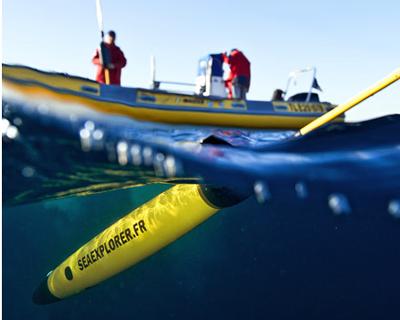Europe’s underwater glider readied for 5 km ocean plunge

Europe’s only deep sea glider is being upgraded so that it can dive 5 kilometres down to scour the pitch-black depths of some of the world’s deepest oceans, enabling it to check on the environmental impact of oil and gas drilling and explore the biodiversity of seabed organisms.
Notes for editors
Europe’s only deep sea glider is being upgraded so that it can dive 5 kilometres down to scour the pitch-black depths of some of the world’s deepest oceans, enabling it to check on the environmental impact of oil and gas drilling and explore the biodiversity of seabed organisms.
SEAEXPLORER, an underwater drone that is fitted with small fins and can stay out for months, gives researchers an alternative to expensive ship-based diving expeditions.
‘You have a buoy in the shape of a torpedo, and it has wings,’ said Dr Mario Brito from the University of Southampton, UK, who is working as part of the EU-funded BRIDGES project to improve the glider.
It uses an oil-filled bladder to adjust buoyancy and moves its battery pack forward and back to control whether the glider is pointing up or down.
‘So as the body moves forward, you have this buoy going down, and because it has wings, it eventually glides in the water,’ said Dr Brito.
Underwater gliders can already reach depths of 1 000 metres, the cusp of the so-called midnight zone which is in permanent darkness, and stay at sea for months. One even crossed the Atlantic Ocean recently.
Now, the BRIDGES project is working out how to make gliders reach depths of 5 000 metres, which would enable them to explore everything but the deepest ocean trenches.
Going deeper with a variety of sensors, including new ones that BRIDGES is also developing, is important in order to expand the gliders’ applications.
‘The oil and gas industry, like sea mining, they’re quite interested in quantifying the environmental impact of certain activities. These gliders will allow us to do that,’ said Dr Brito.
The SEAEXPLORER glider is developed by French company ALSEAMAR and it is currently the only European rival to those produced by US companies. Expanding its underwater range will help it compete in a fast-growing market that covers both industry and research.
‘There are a number of (other) applications,' said Dr Brito. 'For example, people are interested in observing the behaviour of cetaceans, of marine mammals. There are many interests and new ideas for the potential applications of the vehicles.’
Greater control
Previously, researchers who wanted to monitor underwater conditions have had to book expensive ship time. Gliders are not only a cost-effective solution to take long-term measurements, including in remote areas, but they also offer greater control as they can be programmed to move exactly as the scientists want.
‘A typical mission is where you give a glider a number of waypoints - points it must reach - and then you change to other ones as you discover something interesting from the measurements you get from the glider in real time on your desktop,’ said Professor Laurent Mortier, ENSTA ParisTech in Palaiseau, France, who coordinates the BRIDGES project.
He also worked on the EU-funded GROOM project to work out how best to set up dedicated gliderports, integrate gliders into existing ocean monitoring systems and manage the collected data, in order to help scientists use gliders for research and monitoring.
Prof. Mortier says that gliders are currently being used to investigate dead zones – areas of the ocean with zero oxygen and therefore no life – in the eastern Atlantic and Pacific oceans.
‘GROOM has established a quite huge and dynamic community of scientists and engineers both in research institutions and companies, which enabled them to carry the BRIDGES project I’m now coordinating,’ he said.
‘There are a lot of (other) research projects going on at the moment because gliders are affordable and are becoming easier to use for doing complex missions like the ones needed to understand the dead zone behaviour.’
The BRIDGES team is also working to make gliders commercially available for small- and medium-sized companies which have ideas that require ocean exploration but who might not be able to afford ship time or other expensive data collection methods.
One way that they do this is by placing a propeller on the new glider. This will ensure that it can hover in one position and take measurements, for example, close to the bottom. Gliders haven’t done this to date, meaning researchers had to use more expensive equipment to take these kinds of measurements.
Original article from Horizon Magazine